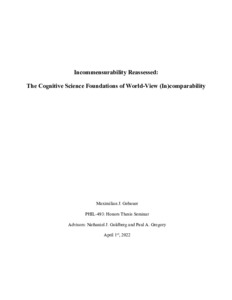Incommensurability Reassessed: The Cognitive Science Foundations of World-View (In)comparability (thesis)

View/
Author
Gebauer, Maximilian James
Subject
Washington and Lee University -- Honors in Philosophy
Structure of scientific revolutions (Kuhn, Thomas S.)
World views
Philosophy and cognitive science
Bird, Alexander James, 1964-
Metadata
Show full item recordDescription
Thesis; [FULL-TEXT FREELY AVAILABLE ONLINE] Maximilian James Gebauer is a member of the Class of 2022 of Washington and Lee University. Thomas S. Kuhn's contributions to the philosophy of science are among the most prominent and contentious of the 20th century; his Structure of Scientific Revolutions remains one
of the most cited philosophical works in recent history, and it has had an impact on historians, literary theorists, political sciences, and sociologists, also. In this work, Kuhn first laid out his incommensurability thesis: theoretical statements from an older scientific paradigm can be untranslatable into those of a later paradigm. Kuhn spent much of his professional life
reformulating this thesis, ultimately giving it an explicitly linguistic form that he termed "taxonomic incommensurability." A large body of secondary literature has developed to explicate and defend various phases of the development of the incommensurability thesis, with several prominent schools utilizing the resources of psychology and cognitive science to provide a naturalized defense of the thesis. This paper's purpose is threefold: to survey the evolution of the incommensurability thesis over the course of Kuhn's career, to explicate the two major schools of secondary literature that refine and defend Kuhnian incommensurability, those being the dynamic-frames account popularized by Andresen, Baker and Chen (ABC) and Alexander Bird's naturalized psychological account, and ultimately to argue that Bird's account, supplemented by Paul Churchland's work on the structure of the brain and its development, is both preferable to ABC's on theoretical grounds and represents a genuine explication of Kuhnian incommensurability as opposed to an independent conception of incommensurability that is only loosely related to Kuhn's version. [From Introduction]